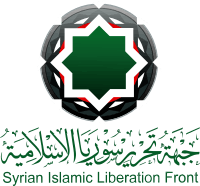Syrian Islamic Liberation Front
| Syrian Islamic Liberation Front جبهة تحرير سوريا الإسلامية Jabha Tahrir Suriya al Islamiyyah | |
|---|---|
| Participant in Syrian civil war | |
 Official logo of the SILF | |
| Active | September 2012 – 25 November 2013 |
| Ideology | Sunni Islamism[1] |
| Leaders |
Ahmed Eissa al-Sheikh (Suqour al-Sham) Zahran Alloush (spokesperson) (WIA) (Liwa al-Islam) |
| Headquarters | Sarjeh, Idlib Governorate |
| Area of operations | Syria |
| Strength |
35,000–40,000 (own claim)[2][3] (June 2013) |
| Became | Islamic Front |
| Allies |
Al-Nusra Front (formerly)[4] Ahrar ash-Sham Free Syrian Army |
| Opponents |
Syrian Armed Forces Ghuraba al-Sham[5] People's Protection Units (YPG)[6] Shabiha[6] |
| Battles and wars | Syrian civil war |
The Syrian Islamic Liberation Front (SILF; Arabic: جبهة تحرير سوريا الإسلامية, Jabhat Tahrīr Sūriyā al-Islāmiyyah), was a coalition of Islamist rebel brigades who fought against the Bashar al-Assad government in the Syrian civil war. By late 2012, it was one of the strongest armed coalitions in Syria,[7] representing up to half of Bashar al-Assad's armed opponents.[2]
In late November 2013, Suqour al-Sham, Al-Tawhid Brigade and Jaysh al-Islam, the largest and most influential members of the Front, announced that they were joining the Islamic Front.[8] On 25 November 2013, a statement appeared on the SILF website announcing that the group was ceasing all operations.[9]
Background
Founded in September 2012 after secret negotiations between the group's leaders, the group was headed by Ahmed Eissa al-Sheikh, the leader of the Suqour al-Sham Brigade. The coalition included around 20 Islamist groups and had tens of thousands of fighters active throughout much of Syria, overshadowing the Free Syrian Army (FSA) in some regions. While some member groups appeared to consider themselves members of both the Syrian Liberation Front and the FSA,[10] Abu Issa said the group aimed to maintain brotherly relations with the FSA while declining to offer full support and criticising those leaders of the FSA that remained in Turkey.[2]
The coalition included some of the most important rebel units active in the civil war, including the Suqour al-Sham Brigade (Idlib), Farouq Brigade (Homs), Liwa al-Islam (Damascus) and Tawhid Brigade (Aleppo).[11] Other prominent groups in the coalition included Liwa Dawud,[12] the Deir ez-Zor Revolutionary Council (Deir ez-Zor), Tajamo Ansar al-Islam (Damascus), Amr Ibn al-Aas Brigade (Aleppo), and al-Naser Salaheddin Brigade (Latakia).[10] These groups were geographically scattered, varied in size and influence, and were dependent on different sources of funding. It was unclear how effectively the coalition coordinated between the varying groups.[10]
Weapons
Abu Issa said that the coalition obtained their weapons from attacks on the Syrian Armed Forces and from arms dealers inside and outside Syria, however, the group reportedly received support from Turkey and Qatar.[13] It had been accused by members of the FSA of monopolizing the supply of weapons through Turkey in order to marginalize unaffiliated rebel groups.[2][13]
Ideology
The group had a Sunni Islamist ideology.[2] It included both Muslim Brotherhood and Salafist inspired groups, however many of the more hardline Islamist groups active in the Syrian civil war were members of the Syrian Islamic Front. The group did not include the jihadist Al-Nusra Front, and Ahrar ash-Sham withdrew from the group in protest at the killing of a jihadist leader by one of the other groups.[2] Some in the FSA criticized the group for its emphasis on an Islamic identity in a religiously mixed country.[2] The group had a minimalist political platform, promising to protect minorities and stating that religious Muslim law was the point of reference for the group.[10] In July 2013, the leader of the group called for sectarian attacks on Alawite homes and villages, but retracted the statement weeks later.[14]
See also
References
- ↑ Sowell, Kirk (3 September 2013). "The fragmenting FSA". Foreign Policy. Retrieved 10 November 2013.
- 1 2 3 4 5 6 7 Karouny, Mariam (11 October 2012). "Syria's Islamist rebels join forces against Assad". Reuters. Retrieved 10 November 2013.
- ↑ Aron Lund (17 June 2013). "Freedom fighters? Cannibals? The truth about Syria's rebels". The Independent. Retrieved 10 November 2013.
- ↑ "Syrian Rebels Break With Group Over Qaeda Wing Alliance". NY Times. 12 April 2013. Retrieved 18 June 2013.
- ↑ "Warring Syrian rebel groups abduct each other's members". Times of Israel. 18 May 2013. Retrieved 25 May 2013.
- 1 2 "Insurgents Declare War on Syria's Kurds". SyriaReport. 27 May 2013. Retrieved 10 November 2013.
- ↑ "Syria's Secular and Islamist Rebels: Who Are the Saudis and the Qataris Arming?". Time Magazine. 18 September 2012. Retrieved 10 November 2013.
- ↑ "Leading Syrian rebel groups form new Islamic Front". BBC. 22 November 2013. Retrieved 23 November 2013.
- ↑ "بيان حل جبهة تحرير سورية الإسلامية | جبهة تحرير سورية الإسلامية". Syrialiberationfront.net. 2013-11-25. Archived from the original on December 16, 2013. Retrieved 2013-12-18.
- 1 2 3 4 Lund, Aron (5 October 2012). "Holy Warriors". Foreign Policy. Retrieved 10 November 2013.
- ↑ "انضمام لواء التوحيد لجبهة تحرير سوريا الاسلامية".
- ↑ "Syria's moderate rebels wane as extremist forces dominate". The National. 31 July 2013. Retrieved 10 November 2013.
- 1 2 "Rebels With a Cause, But Not Much Consensus". Foreign Policy. 1 October 2013. Archived from the original on October 17, 2012. Retrieved 10 November 2013.
- ↑ "Syrian Opposition Condemns Jihadists Targeting Alawites". Al Monitor. 14 August 2013. Retrieved 10 November 2013.
External links
- Syrian Islamic Liberation Front on Twitter (Arabic)
